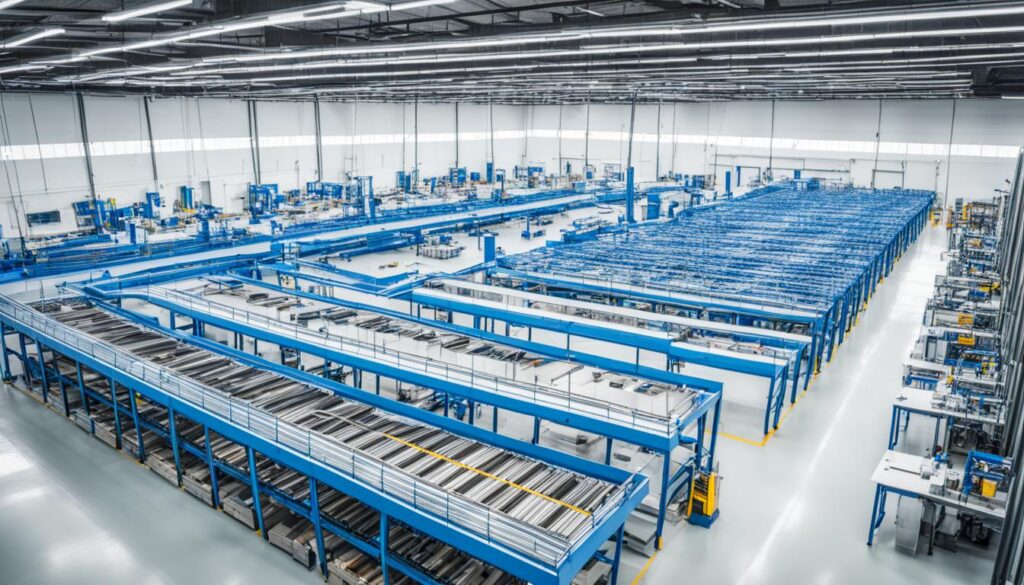Are you searching for methods to make your business better and outlast others in the Philippine market? Lean methodology might be the answer. It could change how your organization works, making it more efficient and productive.
Lean methodology is a structured way to trim down processes, cut out unnecessary steps, and put the customer first. This approach helps businesses in the Philippines spend less, boost their service quality, and succeed better.

Key Takeaways:
- Lean methodology helps businesses in the Philippines maximize efficiency and stay competitive.
- Implementing lean principles can streamline operations, reduce waste, and enhance productivity.
- Lean methodology brings specific advantages to organizations, such as improved operational efficiency and faster response to market demands.
- The core concepts of lean methodology include defining customer value, prioritizing flow and pull, and continuous improvement.
- Waste reduction techniques, such as identifying non-value-adding activities and leveraging lean tools, are essential in the Philippine setting.
Introduction to the Lean Methodology Landscape in the Philippines
Lean methodology is about adding value to customers. It aims to cut down on waste. This approach is becoming very popular among Philippine businesses. They are using it to boost their efficiency and stand out from competitors.
Understanding Lean Methodology
Lean methodology gets rid of things that don’t help customers. It’s all about making things better, all the time. By using lean, companies in the Philippines can stop wasting time and resources. This lets them work better, cut costs, and offer better products and services.
Relevance of Lean in the Philippine Business Context
In the Philippines, business is fast-paced and always changing. Lean helps companies keep up by focusing on what customers want. This way, they can trim any extra activities and work more effectively. It gives them a way to shine in a market that’s always evolving.
Historical Development and Adaptation of Lean Practices
Lean practices in the Philippines have evolved for different fields. They’ve been used in manufacturing, healthcare, logistics, and more. Over time, these industries have seen benefits like less waste, better work flow, and strong, steady progress.
| Industry | Successful Lean Implementation |
|---|---|
| Manufacturing | A leading automotive manufacturer in the Philippines implemented lean practices, reducing production lead times by 40% and increasing overall productivity by 30%. |
| Healthcare | A hospital in Manila adopted lean methodologies in their operations, resulting in improved patient flow, reduced waiting times, and enhanced service quality. |
| Services | A major financial institution embraced lean principles in their customer service processes, significantly reducing customer complaints and improving response times. |
Lean Principles as a Competitive Edge
Lean principles give companies in the Philippines a big boost in the ever-changing business world. They help companies work better, be more efficient, and get more things done. These rules help make more value, work on processes, and always be better, making companies bigger than their rivals.
Using lean methods makes businesses run smoother. They cut down on waste and make operations slimmer. This saves money and makes the business more profitable. With these savings, companies can spend smarter and grow faster.
Also, lean thinking helps companies offer better products and services. By fixing flaws and errors, they make sure they sell top-notch stuff. This makes customers happy and builds a strong brand. It’s a smart way to lead in the market.
Lean ways also help react to what customers want faster. By working on timing, companies can jump on new trends quickly. This makes them stand out and seize new chances before others can.
When companies fully embrace lean, they do amazing things. They run more smoothly, save money, and make better things. By always finding ways to be better and removing unnecessary bits, they get ahead and stay successful for a long time.

Core Concepts of Lean Methodology
To make lean methodology work, knowing its key ideas is essential. It’s about valuing the customer, ensuring smooth work processes, and always working to get better. These principles help businesses change for the better and grow steadily.
Defining Value from the Customer’s Perspective
Lean methodology starts with understanding what customers find valuable. Instead of just improving how things work inside the company, it’s about meeting what the customer wants. This focus on the customer’s perspective guides companies to do only what truly matters to the customer.
When a business knows what their customers value, it can do things more efficiently. This approach doesn’t just make customers happier. It also keeps them coming back and telling others about the great service.
Prioritizing the Flow and Pull of Operations
Lean methodology values a smooth operation flow. It means getting rid of work blockages, waiting times, and ensuring work travels easily through the whole process. Organizations must organize work to flow smoothly, not in separate chunks.
Using pull methods, work only starts when needed. This system reduces waste and ensures companies meet customer needs fast. It means less waiting time for the customer and a more efficient operation.
Perfection through Continuous Improvement
Lean methodology is always about getting better. Companies should constantly look for ways to cut waste, do things more efficiently, and amaze their customers. It’s all about pushing for better and involving everyone in making that happen.
Small changes, done regularly, make a big difference in the long run. With everyone working to improve, a company can be a step ahead of others. This leads to steady success over time.
To conclude, lean methodology has three main ideas. These include valuing the customer, making work flow smoothly, and always finding ways to improve. When businesses in the Philippines put these into practice, they can see big improvements. This includes using time better, cutting waste, and making customers very happy.
Spotlight on Waste Reduction Techniques
Waste reduction is key in lean methodology for better efficiency. By getting rid of activities that don’t add value, companies improve their process. This is crucial especially in the Philippines. Businesses need to use these techniques to keep up.
Identifying and Eliminating Non-Value-Adding Activities
First, organizations need to spot activities that don’t help customers. These can be things like making too much, waiting, moving things too much, and having mistakes. By looking at every step and knowing what customers really want, companies can cut out the unnecessary. This leads to doing things better, saving money, and making customers happier.
Lean Tools for Waste Reduction in the Philippine Setting
In the Philippines, there are special lean tools that can cut down on waste. These tools make work smoother, find what’s not working, and help use resources better. Some tools include:

| Lean Tool | Description |
|---|---|
| 5S | A workplace organization method that focuses on sorting, setting in order, shining, standardizing, and sustaining cleanliness and orderliness. |
| Value Stream Mapping | A visual representation of the flow of materials and information through a process, helping identify areas of waste and inefficiency. |
| Kanban Systems | A pull-based system that ensures materials and resources are replenished only when needed, avoiding excess inventory and waste. |
| Standardized Work | Establishing clear and standardized procedures to minimize variation and improve efficiency in executing tasks. |
| Poka-Yoke | Implementing foolproof mechanisms or devices to prevent errors and defects, improving overall quality. |
| Total Productive Maintenance | A holistic approach to equipment maintenance that aims to maximize equipment effectiveness and minimize breakdowns. |
By using these lean tools, companies in the Philippines can make big improvements. They’ll cut waste, do more, and outshine others in the market.
The Role of Kaizen in Sustaining Efficiency
Kaizen is essential for keeping organizations efficient. It’s a key part of the lean approach. Kaizen means always getting better by making small, smart changes. These changes add up and improve the overall efficiency. This way, companies keep growing and succeeding.
Using kaizen at work has many pluses. One big one is that it gets everyone more involved. When workers help make things better, they feel like they own the process. This boosts their happiness and makes them work harder. Everyone working together like this helps the company improve over time.
Kaizen also makes teams better at solving problems. It teaches workers to spot what’s not working and fix it. This skill is super important for companies. It helps them stay strong in a world that’s always changing.
Improving productivity is another win with kaizen. By always looking to cut out waste, companies get better and faster at what they do. This isn’t about big changes but lots of small, smart tweaks. This keeps things running smoothly while getting more done.
Kaizen’s impact on efficiency is huge. It highlights improvement and gives power to the people. This method doesn’t just make work better; it changes how people think and act. It turns a company into a place of constant innovation and growth. Embracing kaizen is great for lasting success in today’s fast-changing business world.
Lean Methodology in the Philippine Market
Adapting Lean to the Philippine Market Dynamics
Lean methodology fits well in the ever-changing Philippine market. To succeed, organizations must grasp the country’s unique challenges. They then tailor lean practices to their needs, reaping its benefits.
Lean focuses on doing more with less, perfect for those aiming to boost efficiency. Through local adaptation, Philippine businesses can sharpen their processes. This helps them stand out from the competition.
Adapting lean for the Philippine market means considering local culture, available resources, and what the market wants. Organizations should blend international principles with local strengths. This mix leads to effective results.

Value Stream Mapping to Enhance Productivity
Value stream mapping is a key part of lean methodology. It helps organizations see and fix how things and info flow in their processes. This lets them understand their process fully. They can then see where to improve.
Value stream mapping enables organizations to:
- Identify bottlenecks and waste in the value stream
- Streamline processes to improve overall efficiency
- Reduce lead times and enhance customer satisfaction
- Identify and eliminate non-value-adding activities
When doing a value stream mapping exercise, steps are followed:
- Choose a process or stream to map
- Create a detailed flowchart of what happens now
- Look at the flowchart to find problems and waste
- Create a better flowchart for the future
- Making the changes needed to reach the future state
Using value stream mapping helps organizations a lot. They improve how things and info move. This makes processes work better, with less time and more productivity. It also lets companies focus on what customers really find valuable. And every step adds to customer happiness.
Next, we’ll look at how lean methods work in making things in the Philippines and how tech fits with lean.
Lean Manufacturing and Industrial Evolution in the Philippines
In the Philippines, lean principles are changing how we make things. The country’s manufacturing sector is evolving fast. Companies see the advantages of going lean. It helps them work better, save time, and stay ahead of others.
Integrating Technology with Lean for Modern Manufacturing
Using tech is key for lean manufacturing in the Philippines. It lets companies do more with less, improving their ways of working. Thanks to technology like automation and data analysis, makers can boost their output and cut down on mistakes.
One crucial tech tool is value stream mapping software. It makes production processes clear and highlights any slowdowns. By looking at the big picture, makers can make smart choices. They can better arrange their spaces, mix up how they work, and dump what’s not helpful.

Tech and lean make Philippine makers more efficient, accurate, and ready to compete.
Cross-Industry Applications of Lean Manufacturing
Lean methods aren’t just for one type of business. They work in lots of sectors here, like cars, electronics, and food. These industries have made great strides using lean. It has helped them be top-notch at what they do.
Take the car world, for example. Lean thinking has turned their ways of making cars around. With lean, they now work faster, better, and have more satisfied customers.
The power of lean stretches far. It doesn’t matter if you make things or provide services. Lean can help any business get smoother, do more, and keep up with what’s happening in the world.
Examples of Cross-Industry Applications of Lean Manufacturing in the Philippines
| Industry | Application of Lean Principles |
|---|---|
| Automotive | Implementation of just-in-time production, reduced setup times, and continuous flow manufacturing. |
| Electronics | Elimination of defects, optimized material handling, and implementation of visual management systems. |
| Food and Beverage | Streamlined supply chain processes, minimized inventory waste, and enhanced production line efficiency. |
| Pharmaceuticals | Standardized work procedures, error-proofing mechanisms, and optimized batch production processes. |
| Textile Manufacturing | Reduced setup times, balanced workloads, and application of 5S methodology for efficient workspace organization. |
Lean works well in many fields in the Philippines. This shows how useful it is. From cars to clothes, lean helps businesses work better, making them more competitive.
Building a Lean Culture within Filipino Organizations
Creating a lean culture in Filipino organizations goes beyond just adopting lean methods. It requires setting up a complete system. This includes training the staff and building a sense of ownership for lean practices.
Training and development are key. They arm employees with the knowledge to use lean principles daily. This investment helps the staff drive constant improvement and get the most from lean practices.
Ownership and accountability are crucial elements of a lean culture. Employees must own the lean process and feel empowered to help improve. This encourages everyone to actively spot and solve problems, refine processes, and maintain improvements.
To cultivate a lean culture, organizations should follow certain strategies. These are developed to support the use of lean practices:
- Have a clear vision and mission focused on lean principles and how they align with goals.
- Offer regular training for employees to boost their lean knowledge and skills.
- Set up good communication to share ideas, feedback, and improvement suggestions easily.
- Reward employees for their lean contributions, promoting a culture of always getting better.
- Create teams that bring together people from various departments to share knowledge.
- Use a system to measure performance, find bottlenecks, and promote accountability.
- Encourage leaders to set an example and show a strong commitment to lean principles.
- Have regular gatherings for employees to share concerns, offer ideas, and help with lean efforts.
By following these strategies and encouraging a culture focused on continuous improvement, Filipino organizations can create a solid base for adopting lean practices. This approach will lead to lasting efficiency gains, better productivity, and a competitive position in the challenging Philippine market.
Conclusion
In closing, using lean methodology can really help companies in the Philippines. It boosts how well a company works which makes things smooth and productive. This method cuts down on waste and keeps making things better, helping companies stand out in a busy market.
Lean is big in the Philippines because it tackles challenges and grabs chances head-on. Thanks to its growth and changes over time, it’s proven itself in many local trades. It focuses on cutting wasted efforts and uses tools like 5S and kanban to make things run better.
To keep getting better, companies can create a lean-minded group and offer ongoing training. This way, everyone is responsible for making things leaner and improving how they work together. By being lean, businesses in the Philippines can really soar, work better, and succeed over time.
